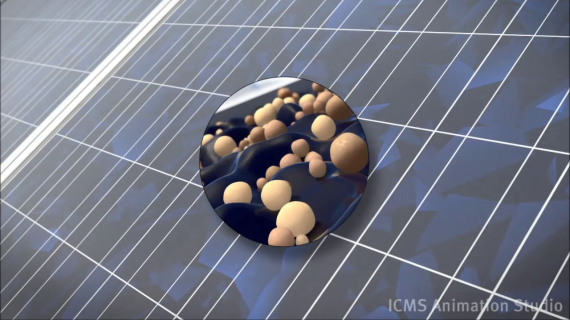© Eindhoven University of Technology
Current solar panels contain a static coating, which makes them susceptible to dirt and creates the necessity for a window cleaner to clean them once in a while to guarantee the generation of solar energy. Van der Kooij is working on thin coatings of liquid crystals that can vary in shape and function through the application of electric currents. This makes it possible to have the varnish layers vibrate in order for dirt and sand particles to fall off the solar panels.
Robot digits
Materials that change shape and function already exist, says Van der Kooij, who is a PhD candidate at the Physical Chemistry and Soft Matter group. For example, every smartphone has a touchscreen: a thin layer that responds to touch, allowing the user to swipe. And the Eindhoven researchers Dirk Broer and Danqing Liu are working on wafer-thin coatings on glass that can keep windows clean, for example, and on coatings for robots that can harden or soften their fingers, so that they can pick up both a brick and raspberry.
Liquid crystals
The secret to these thin and flexible layers is liquid crystals. Most televisions already have such a liquid crystal display (LCD), but Van der Kooij expects that they will be processed in many other coatings. ‘In our research, the liquid crystals are located in a thin, hard layer, but when electricity is led through this layer, the crystals start to rotate and vibrate, and the layer becomes soft and flexible.’ The Eindhoven researchers discovered that this does not occur with normal alternating current from the wall, but when using high-frequency alternating current.
Laser
However, their technique to produce these dynamic coatings is still very expensive and requires high amounts of energy, because the researchers do not yet fully understand the fine details of the relation between the current and the material deformation. That is why they came to Joris Sprakel’s research group in Wageningen, as the group disposes of laser equipment that can measure such relations and interactions very accurately. Van der Kooij: ‘We have developed a method that measures with very high sensitivity how the material deforms under the influence of electricity. We have discovered entirely new things.’ This led to an article in the journal Nature Communications last week.
Collaboration
Using laser light, Van der Kooij discovered that there are three stages between supplying power and the deformation of the material. In the first phase, the liquid crystals start to vibrate independently and very quickly under the influence of the electricity. In the second phase, the crystals start to synchronise; almost as if they worked as a collective. This makes the layer soft to the touch. And in the third phase, this process allows the coating to deform. The first processes happen in a split second at the nanoscale.
Cheaper
From this basic knowledge, the researchers in Eindhoven can now finetune the interaction between current and liquid crystals, so that more electricity is converted into kinetic energy. ‘This makes the process more efficient and makes the dynamic coatings cheaper and more energy efficient.’
Application of the technology is already on its way. Eindhoven University of Technology is collaborating with pilot factories in China, where these dynamic coatings are already being produced on a larger scale, says Van der Kooij.

